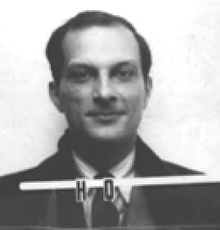Stanislaw Marcin Ulam

Stanisław Marcin Ulam (also Stanley Ulam ; born April 13, 1909 in Lemberg ; † May 13, 1984 in Santa Fe ) was a Polish - American mathematician .
Live and act
Ulam came from a Polish-Jewish middle-class family with relatives in the banking and woodworking industries; his father was a lawyer.
His mathematics teacher was the Polish mathematician Stefan Banach , one of the leading figures of the Lviv math school . In line with the orientation of the Polish school, Ulam mainly dealt with questions from dimension theory , topology and logic . Intensive discussions in cafes were also typical in Poland, and Ulam later collected the problems discussed at the time in a few books, e.g. B. in " The Scottish Book " after the " Scottish Cafe ".
In 1930 he introduced the concept of the measurable cardinal number (a special large cardinal number , the cardinal number of a set for which an -additive (0,1) -valent measure can be defined on the power set ) and proved that these are highly unreachable. The concept has proven fruitful for axiomatic set theory .
Ulam went to the United States as a Harvard Junior Fellow in 1938 at the invitation of George David Birkhoff . During this time he and John C. Oxtoby proved the Oxtoby and Ulam theorem on the ergodicity of measure-preserving homeomorphisms of manifolds. In 1940 he became an Assistant Professor at the University of Wisconsin and supported his brother Adam , who had emigrated from Poland on the eve of the Second World War . In 1943 he became a US citizen and in the same year his friend John von Neumann invited him to a secret project in New Mexico . Ulam became a member of the Manhattan project .
Ulam was involved in the early development of nuclear weapons . He showed that Edward Teller's early model of the hydrogen bomb was inadequate. Ulam began to develop a better method. He was the first in the US to find that you can put all the components of an H-bomb in a sleeve, a fission bomb on one end and the thermonuclear material on the other, and then use the shock waves from the fission bomb to destroy the To compress the fusion substance and let it explode. Teller initially contradicted this idea, but then recognized its merits and suggested the use of X - rays or gamma rays instead of shock waves. "Radiation implosion" - as the method was then called - has since been the standard method for igniting hydrogen bombs (see Teller-Ulam design ).
Ulam developed the Monte Carlo method together with John von Neumann to evaluate complicated mathematical integrals with the help of random numbers while working on theoretical problems during the Manhattan Project in Los Alamos . He worked on one of the first major numerical simulations on computers, the Fermi-Pasta-Ulam experiment , which showed the chaotic behavior of non-linearly coupled oscillator chains.
His name is also known from investigating the Collatz problem ; the function used there is sometimes called the " ulam function ". The pattern of the Ulam spiral , a graphic representation of prime numbers, has also not yet been resolved .
Stanislaw Ulam made a proposal for a nuclear pulse drive that should propel a spaceship by atom bomb explosions. However, the secret Orion project , which took up Ulam's suggestion in the mid-1950s, remained at the stage of a feasibility study . In 1957 Ulam was elected to the American Academy of Arts and Sciences , 1966 to the National Academy of Sciences and 1967 to the American Philosophical Society .
Fonts
- Collection of Mathematical Problems , New York 1960
- Sets, Numbers and Universes , Cambridge, Massachusetts 1974, ISBN 0-262-02108-0
- Mathematic and Logic with Mark Kac , New York 1986, ISBN 0-486-67085-6
- The Scottish Book: A Collection of Problems , Los Alamos 1957
- Adventures of a Mathematician , Berkeley, California 1976, ISBN 0-520-07154-9
Detailed bibliography in the special issue on Ulam, Los Alamos Science 1987.
See also
literature
- Donald J. Albers, GL Alexanderson Mathematical People - Profiles and Interviews , Birkhäuser 1985
Web links
- Literature by and about Stanisław Marcin Ulam in the catalog of the German National Library
- Los Alamos Science special on Ulam, 1987
- Contributions by Ulam from his time in Poland to the Fundamenta Mathematicae
- To "The Scottish Book"
- John J. O'Connor, Edmund F. Robertson : Stanisław Marcin Ulam. In: MacTutor History of Mathematics archive .
- Stanislaw M. Ulam Papers The American Philosophical Society Library
- Stanislaw Ulam @ aip.org
Individual evidence
- ↑ Ulam on the theory of measures in general set theory , Fundamenta Mathematicae, Volume 16, 1930, pp. 140–150
| personal data | |
|---|---|
| SURNAME | Ulam, Stanislaw Marcin |
| BRIEF DESCRIPTION | Polish-American mathematician |
| DATE OF BIRTH | April 13, 1909 |
| PLACE OF BIRTH | Lwów (Lviv) |
| DATE OF DEATH | May 13, 1984 |
| Place of death | Santa Fe |
